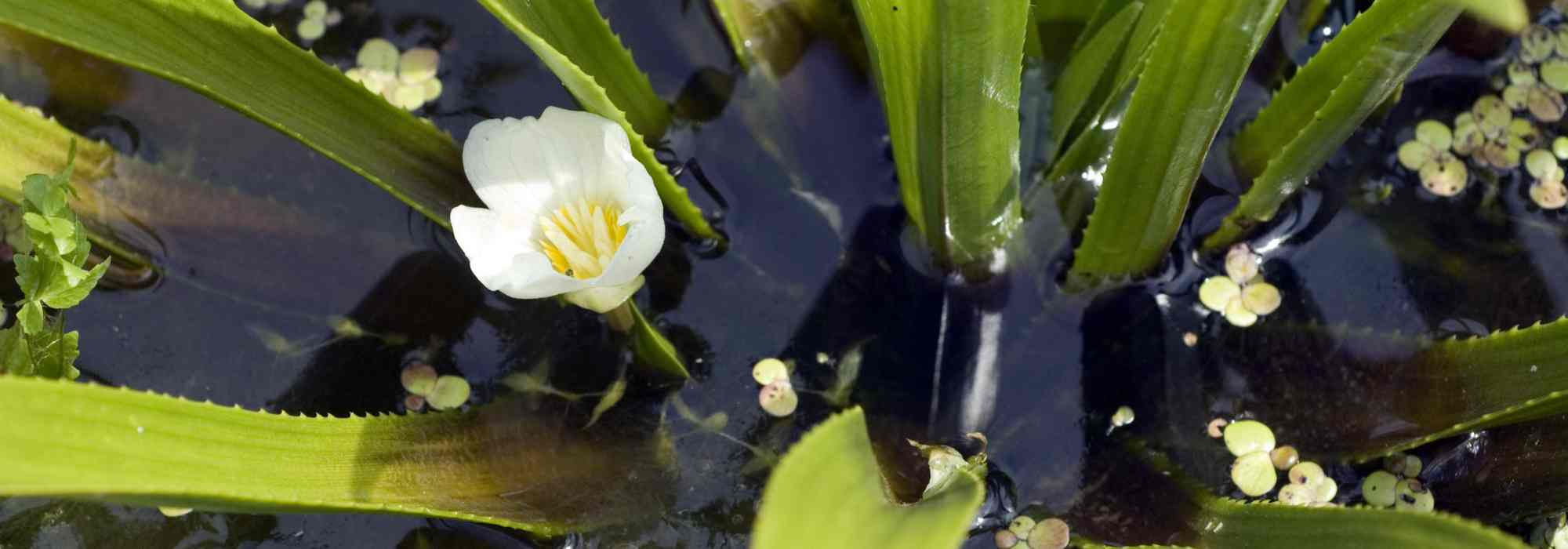
Water soldier - Stratiotes aloides: planting and growing
Contents
The water aloe in a few words
- The water aloe (Stratiotes aloides) is an aquatic plant that floats or is semi-submerged, thriving in the calm, sunny waters of ponds and pools.
- This perennial forms rosettes of rigid, dentate leaves and produces white flowering in spring and summer.
- It contributes to ecological balance by oxygenating the water, limiting algae through its shade, and providing shelter for aquatic wildlife.
- Easy to propagate by dividing its rosettes, the water aloe requires little maintenance but should be monitored to prevent it from becoming invasive.
- Ideal for water gardens, it can be paired with water lilies, other oxygenating plants, or water irises to create a pond that is both aesthetic and ecological.
The word from our expert
The water aloe, Stratiotes aloides, is a true marvel of ponds and wetlands, an aquatic plant that seems to draw its strength from the very water in which it thrives. This perennial, with its robust yet graceful appearance, evokes a terrestrial aloe with its long dentate leaves, but it is in the aquatic element that it fully displays its majesty. Observing this plant is like witnessing a subtle dance between elegance and functionality, between natural adaptation and ecological contribution.
In a pond, the water aloe quickly becomes a centrepiece. Its floating rosettes rise to the surface, like a vegetal crown resting on the water. Its stiff, tapering leaves, of a deep green, seem straight out of a natural armour, ready to defy wind and weather. But this warlike appearance conceals a delicate role: by shading the water with its leaves, it protects the aquatic ecosystem, limiting algae proliferation while oxygenating the water.
Then come the flowers. In May or June, pristine white flowers emerge on the surface, carrying in their simplicity an almost supernatural beauty. Their brilliance catches the eye, and their more humble yet equally essential role is to ensure the perpetuation of this fascinating aquatic species, through water-borne pollination. These little wonders float discreetly, but their presence enhances every corner of the pond or water feature where they reside.
Beyond its beauty, the water aloe is a precious ally for aquatic ecosystems. In wetlands, it serves as a refugium for diverse wildlife: fish find shelter there, insects find a playground, and aquatic birds find a source of life. Even in winter, it demonstrates incredible resilience by sinking into the depths, escaping the frost, only to re-emerge in spring.
Cultivating the water aloe is cultivating balance. With a little care and attention, it becomes the symbol of a healthy, vibrant pond. Paired with water lilies or irises, it creates a living tableau, oscillating between the wild and the refined. And it is this duality, this ability to be both a utilitarian plant and a natural work of art, that makes Stratiotes aloides an exceptional aquatic plant.
The water aloe, ultimately, teaches us the harmony between strength and delicacy, between beauty and utility. It is a lesson in nature offered to those who take the time to admire it.
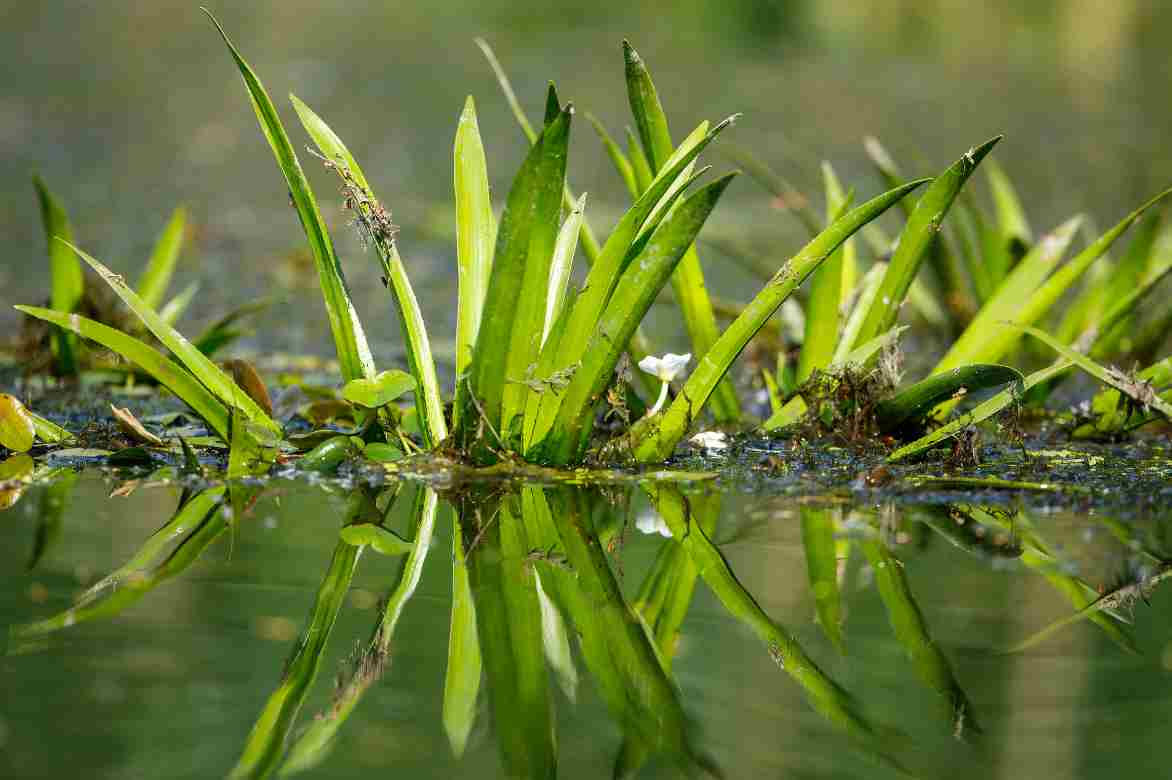
Stratiotes aloides
Botany and description
Botanical data
- Latin name Stratiotes aloides
- Family Hydrocharitaceae
- Common name Water aloe, Water pineapple
- Flowering May to July
- Height 40 cm
- Exposure Sun
- Soil type Clayey and moist
- Hardiness -20°C
The water aloe, also known by its scientific name Stratiotes aloides and its common names such as water soldier, aquatic aloe, or water pineapple, is an aquatic plant belonging to the Hydrocharitaceae family (Hydrocharitaceae). The genus name, Stratiotes, originates from the ancient Greek word “stratiotēs,” meaning soldier, a reference to its robust, sword-shaped leaves, evoking a natural armour.
In its natural habitat, this plant is typical of stagnant or slow-moving waters, such as ponds, ditches, lakes, and marshes. It thrives particularly in fresh, nutrient-rich water while requiring good light to fully develop. Native to Europe and Asia, Stratiotes aloides is mainly found in northern and central Europe, from the Netherlands to Scandinavia, through Germany and the United Kingdom. It extends as far as Russia and western Siberia. However, in some regions, this plant has become rare, mainly due to pollution and habitat destruction. Because of the decline in natural wetland habitats, it is a protected plant in France.

Foliage and flowering of Stratiotes aloides. On the right, a botanical plate (circa 1903).
The water aloe is a perennial aquatic plant that forms beautiful floating rosettes on the surface, reminiscent of terrestrial aloes. These rosettes, compact and elegant, can measure between 20 and 50 centimetres in diameter, with rigid, sharp leaves. Their lance-shaped form, combined with finely serrated edges, gives them a unique and functional appearance. These leaves, which can grow up to 60 centimetres long, display shades of light to dark green, sometimes dotted with reddish hues as they age. Beyond their beauty, the leaves play an essential ecological role by oxygenating the water and limiting algae proliferation by shading the water surface.
The root system of this plant is primarily floating, with roots extending into the water to absorb dissolved nutrients. Although it may occasionally anchor temporarily in sediments, it remains primarily a floating species. This characteristic allows it to adapt to variations in water depth and light in its aquatic environment.
In spring and summer, the water aloe stands out for its delicate flowering, which typically occurs between May and July. The flowers, borne on the water’s surface, are unisexual and illustrate the dioecious nature of the plant, with distinct male and female individuals. The white flowers, with pale yellow centres, measure about three to four centimetres in diameter. The male flowers, slightly larger and more spectacular, contribute to pollination, a process facilitated by water, thanks to an adaptation called hydrophily (pollen is transported by water).
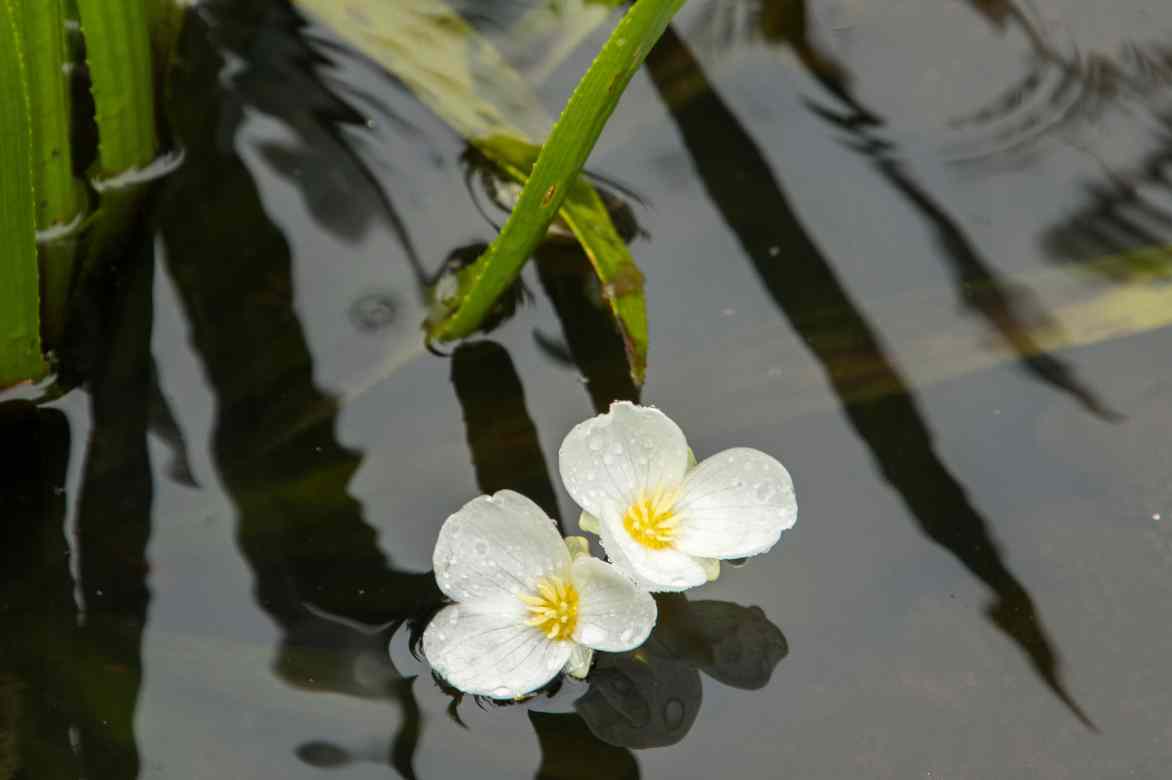
Flowering of Stratiotes aloides
The fruiting of the water aloe remains a rare event, especially outside its natural habitat. When it occurs, it produces small ovoid fruits filled with seeds, maturing underwater. However, this plant primarily propagates vegetatively, through its stolons, creeping lateral stems that allow rapid colonisation of favourable aquatic areas.
The water aloe plays a significant ecological role in its ecosystem. It provides valuable shelter and breeding grounds for many aquatic species, from fish to insects. In winter, this plant adopts a remarkable survival strategy: it sinks into the depths of water bodies to escape freezing, resurfacing with the return of warmer weather thanks to its air-filled tissues.
Finally, this plant is not only useful in its natural habitat. In artificial ponds, it is highly valued for its aesthetic appeal and its ability to purify water by absorbing excess nutrients. It is also used in phytoremediation* programmes to combat eutrophication**. However, its excessive proliferation, possible in nutrient-rich waters, can sometimes become problematic, requiring careful management.
*Phytoremediation is an ecological technique that uses plants to clean up polluted soils, water, or air by absorbing, degrading, or immobilising contaminants.
**Eutrophication is an ecological imbalance in aquatic environments caused by an excess of nutrients (notably nitrates and phosphates), leading to algal blooms and a decrease in available oxygen, threatening wildlife and flora.
Our favourite varieties
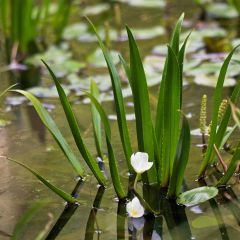
Stratiotes aloides
- Période de floraison June to August
- Hauteur à maturité 40 cm
Planting a water aloe
Where to Plant?
The water aloe should be placed in a calm body of water, such as a pond or lake. It prefers:
- A sunny or lightly shaded area.
- A water depth between 30 and 100 cm. Below or above this range, the plant may struggle to adapt.
- A nutrient-rich substrate to encourage its growth if you wish to anchor it.
- It dislikes excessively high temperatures, so avoid placing it in waters where temperatures can exceed 22°C.
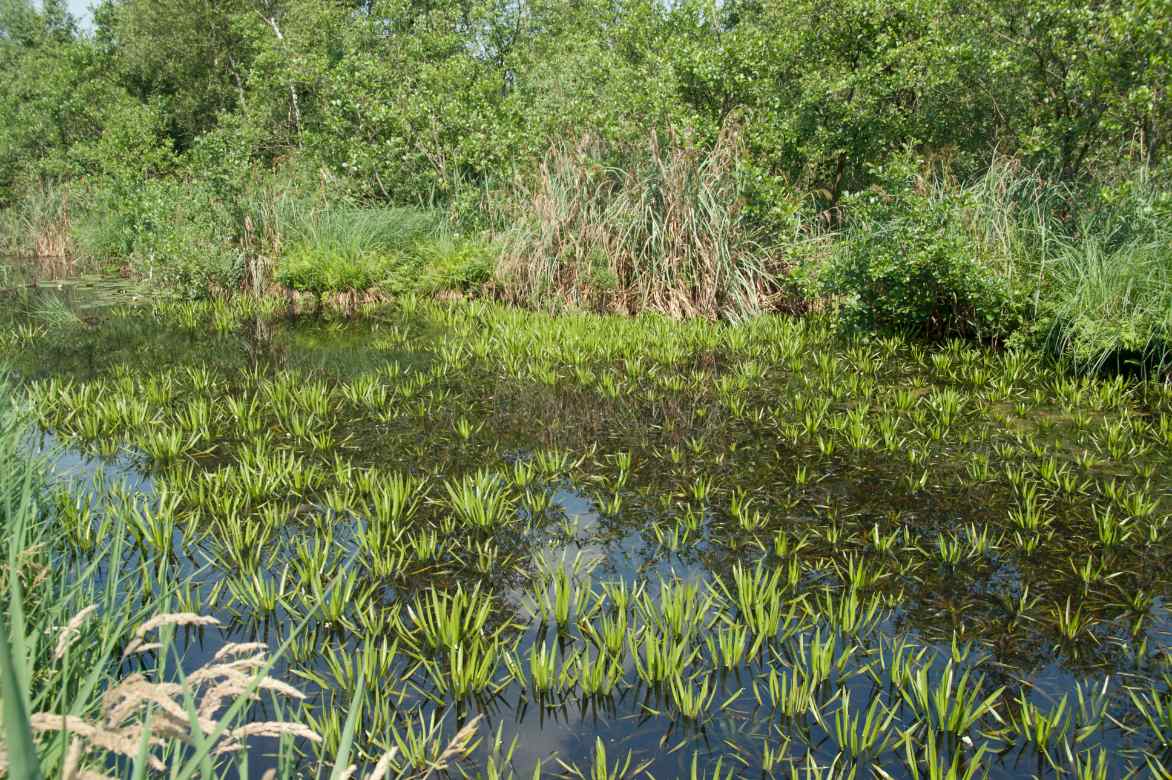
A Note on Substrate
If you wish to plant in a basket, opt for a specially designed substrate, typically composed of a mix of clay, sand, and decomposed organic matter. This type of substrate is heavy enough to stabilise the plant and prevent it from floating or dispersing in the water.
To complement this, it is advisable to add a layer of gravel or coarse sand, about two to three centimetres thick, on top of the substrate. This helps keep the substrate in place while preventing nutrients from leaching into the water.
Finally, avoid using fresh organic matter, such as undecomposed compost. These materials could overly enrich the water with nutrients and promote eutrophication, an ecological imbalance harmful to the pond.
When to Plant?
The best time to “plant” the water aloe is in spring (April) or late summer (September), when temperatures are still mild or the water begins to warm. This allows the plant to establish itself before winter.
How to Plant?
-
- Recommended! For floating planting, simply place the water aloe rosettes on the surface. They will adapt naturally, and their roots will float in the water. The silt at the bottom of the pond should consist of slightly acidic clay.
- For anchored planting: secure the plant in a basket with aquatic substrate and place it at the bottom of the pond at the recommended depth. Unfortunately, this method goes against the plant’s biology. Prefer the first option, which is much more natural!
Maintenance of Water Aloe
Maintaining Stratiotes aloides is relatively straightforward, as this aquatic plant is robust and self-sufficient under the right conditions. Here are the key aspects to consider for its care and to maintain its balance in a pond or water garden:
Monitoring Growth
The water aloe spreads quickly via its stolons. In a small pond, it can become invasive. To prevent overcrowding:
- Regularly remove excess rosettes, especially in summer, when the plant is in full growth.
- Divide clumps if they become too dense, which also helps renew the population and encourages healthy growth.
Removing Dead Leaves
Over time, some leaves may yellow or decompose:
- Remove them by hand to prevent them from breaking down in the water and contributing to organic matter buildup, which could lead to eutrophication.
Natural Wintering
The water aloe adopts a natural strategy for winter:
- As the cold sets in, it sinks to the depths of the pond, where it remains dormant, protected from frost. No special care is needed during this period.
- In spring, the plant will resurface to resume its growth cycle.
Managing Light and Nutrients
The water aloe requires light to thrive:
- Avoid letting the pond become entirely covered by other floating plants, such as duckweed, which could smother it.
- Ensure a balanced nutrient level in the water. If the water becomes too rich, reduce the input of organic matter (like leaves or plant debris) or add other aquatic plants to absorb excess nutrients.
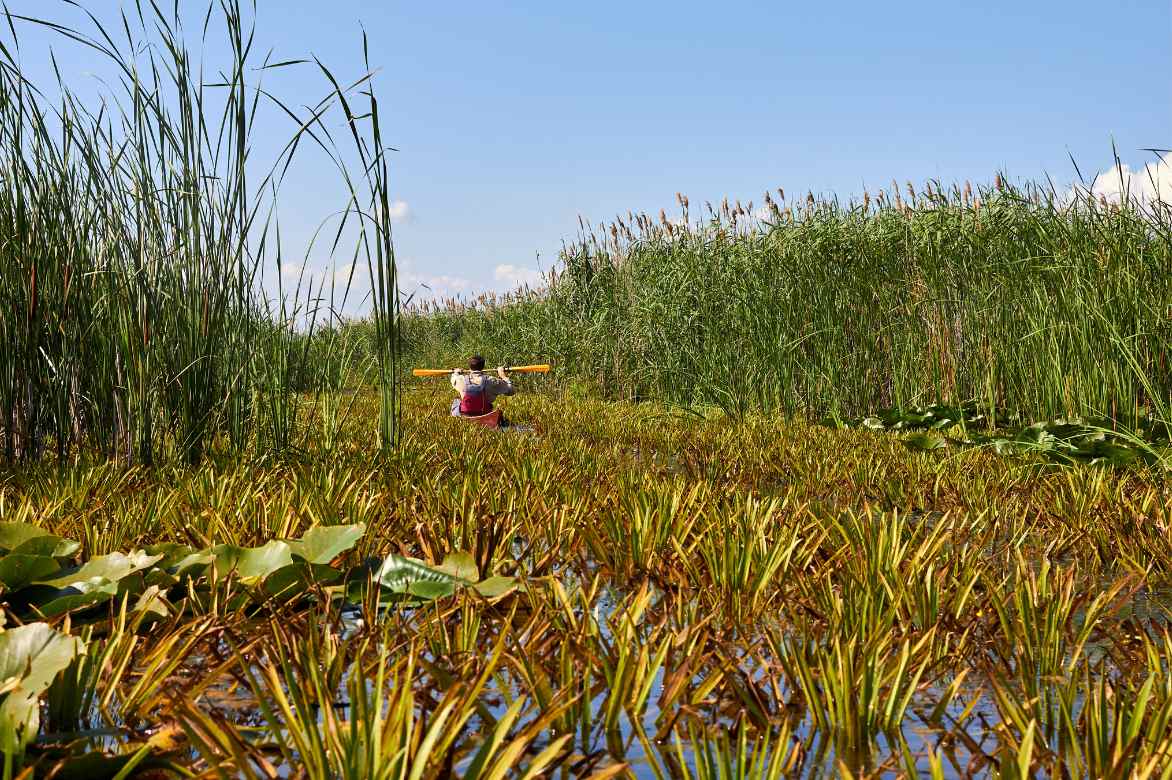
In some countries, the plant has become invasive
Possible diseases and pests
Possible Diseases
- Filamentous algae
Algae can proliferate in nutrient-rich water, covering the leaves of the aquatic aloe and limiting the available light. Although not a disease in itself, suffocation by algae can weaken the plant.- Prevention: maintain a good nutrient balance in the water and introduce other aquatic plants to limit excess.
- Leaf rot
In poorly oxygenated or stagnant water, the leaves may begin to rot, especially if covered with organic debris. This can affect the overall health of the plant.- Prevention: regularly remove dead or damaged leaves to prevent decomposition.
Potential Pests
- Aquatic aphids (notably Rhopalosiphum nymphaeae and similar species)
These small sap-sucking insects can infest the emerged leaves of the aquatic aloe, causing the plant to weaken.- Treatment: rinse infested leaves with fresh water or allow natural predators like ladybirds to intervene.
- Aquatic beetle larvae
Some aquatic insect larvae may nibble on the leaves or roots of the aquatic aloe, causing minor damage.- Natural solution: introduce fish that feed on these larvae, such as gambusia or carp.
- Aquatic snails
Some snails, although useful for cleaning ponds, may sometimes chew on the leaves of the aquatic aloe, especially if other food sources are lacking.- Prevention: monitor the snail population and remove excess if necessary.
None of these “pests” are truly harmful in the case of the aquatic aloe, so don’t worry too much and let nature take its course. In 95% of cases, nothing will happen.
Propagation of the aquatic aloe
The aquatic aloe primarily (and easily!) propagates through vegetative division. Seed formation is very rare.
Propagation by dividing rosettes
The aquatic aloe can simply propagate naturally via its stolons. The creeping stems that form around the main plant will give rise to new rosettes without human intervention. If you wish to encourage this natural propagation, ensure the stolons remain in contact with the water. They will eventually develop roots and produce new rosettes, which can be separated once sufficiently developed.
- When to divide?
The best time to perform this division is in spring or early summer, when the plant is in full growth. This allows the new rosettes to establish well before winter arrives. - How to divide?
- Remove the mother plant from the water gently to access the rosettes formed around the main plant.
- Separate the rosettes: each rosette is attached to the plant by a stolon (a creeping stem). Use your hands or a clean, sharp knife to cut the stolons and separate the rosettes.
- Replant the rosettes: the separated rosettes can be floated directly on the water’s surface or anchored in a light aquatic substrate if you prefer to secure them.
Care for new plants
The new rosettes, whether divided or formed naturally, require the same conditions as the mother plant:
- Nutrient-rich water, without excess.
- Good sunlight and a calm pond environment.
How to best pair water aloe with other aquatic plants?
With its elegant silhouette and floating habit, the water aloe can integrate perfectly with a wide variety of aquatic plants, whether floating, submerged, or marginal.
For visual and ecological balance, it is wise to combine the water aloe with plants that occupy different levels of the pond. On the surface, it can be paired with delicate floating plants like water lilies (Nymphaea), which bring large round leaves and colourful flowers that contrast with the water aloe’s sleek rosettes. Other floating plants, such as the frogbit (Hydrocharis morsus-ranae), can also be used, but sparingly to avoid blocking the light the water aloe needs.
In submerged areas, oxygenating plants like spiked water milfoil (Myriophyllum spicatum) or common water crowfoot (Ranunculus aquatilis) complement the water aloe perfectly. These plants help maintain clear, well-oxygenated water.
The marginal zones, where water meets the banks, offer another level of association. Plants like yellow flag iris (Iris pseudacorus), broadleaf cattail (Typha latifolia), or water horsetail (Equisetum fluviatile) add height and texture that contrast with the water aloe’s floating habit. These marginal plants are ideal for filtering water by capturing excess nutrients, thus reducing the risk of eutrophication.
Finally, to enhance aesthetic appeal while preserving the pond’s balance, it is important to ensure that none of the associated plants dominate the medium. The water aloe, though robust, can be outcompeted by overly prolific species. Regular management, such as controlling the spread of floating plants or thinning clumps of marginal plants, will help maintain a harmonious space where each plant finds its place.
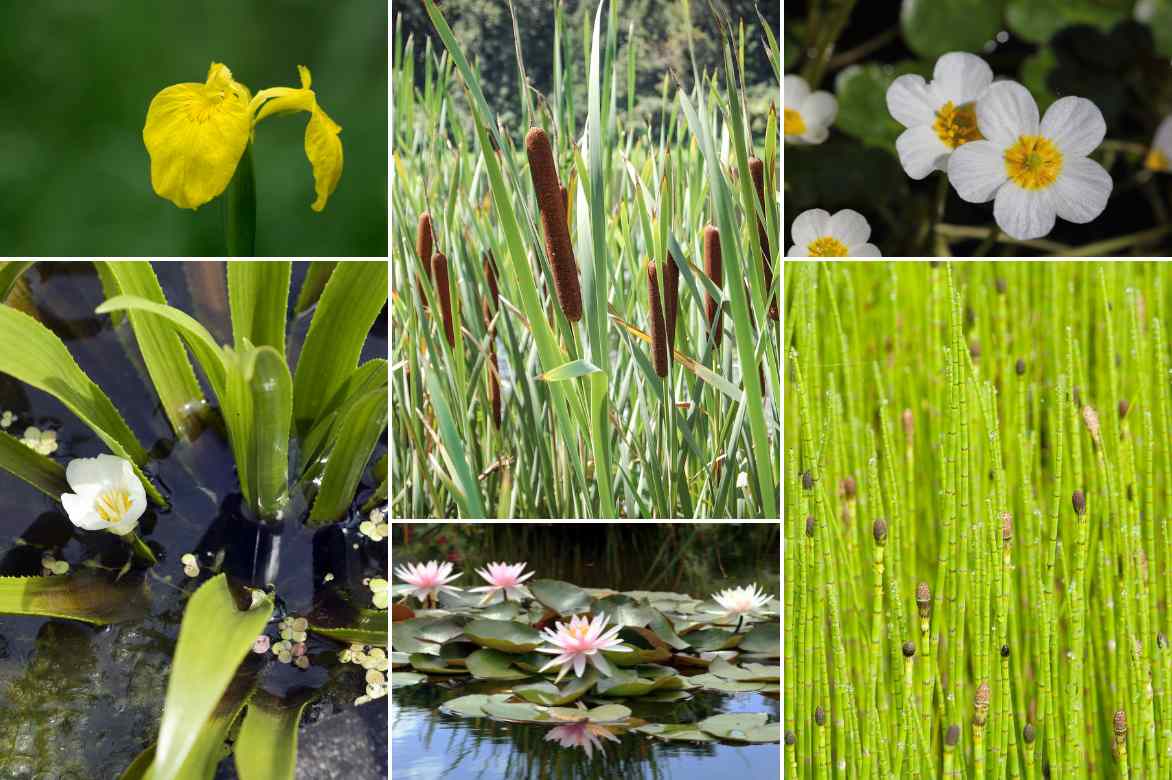
Around the Stratiotes aloides: yellow flag iris, broadleaf cattail, common water crowfoot, water lilies, and water horsetail.
Also see
- Discover all our aquatic plants by planting depth
- Other floating aquatic plants in our online nursery
- Subscribe!
- Contents
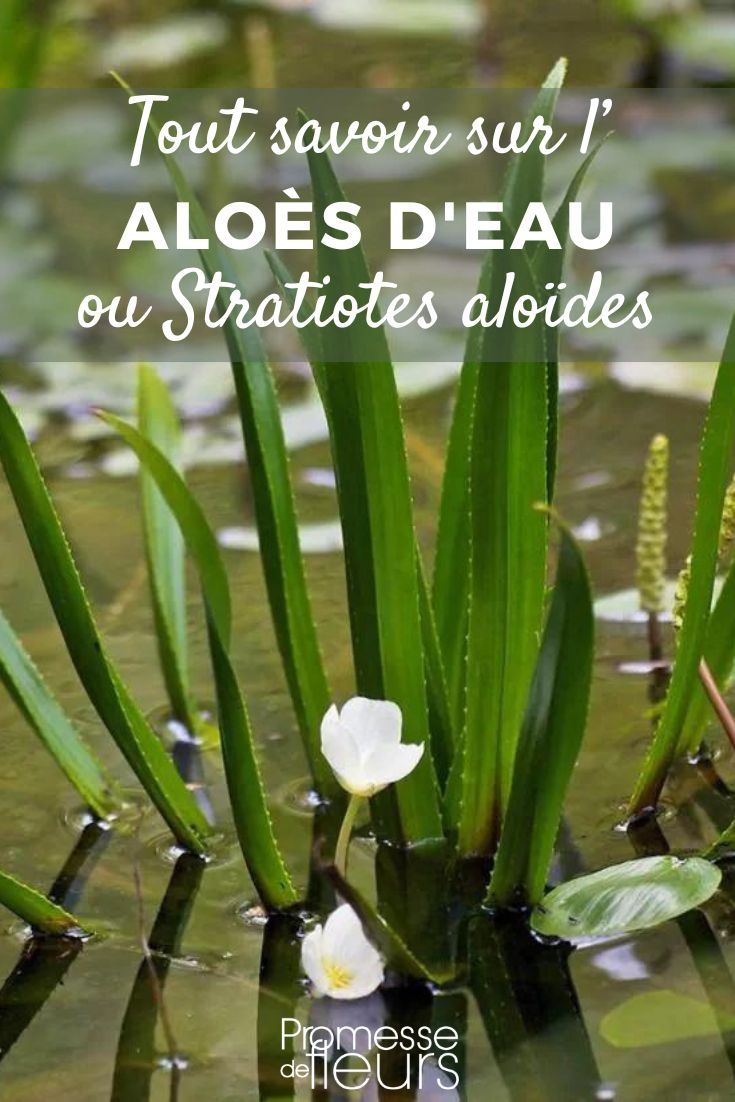































Comments